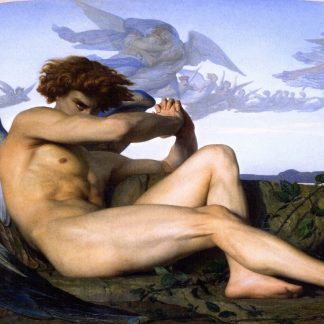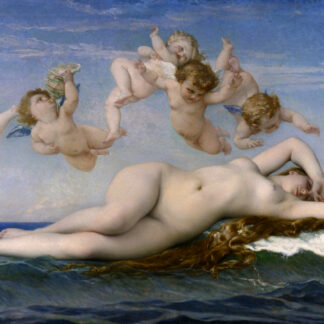Alexandre Cabanel (1823-1889) was a French painter who was known for his academic style and his depictions of historical and mythological subjects. Born in Montpellier, France, Cabanel studied at the Ecole des Beaux-Arts in Paris and became a prominent member of the academic art establishment. He was known for his meticulous attention to detail, his use of vibrant colors, and his skillful rendering of the human form.
Cabanel’s paintings often featured classical themes and subjects, such as the mythological figure of Venus, as well as historical scenes, such as the death of Julius Caesar. His paintings were characterized by their grandeur and their attention to detail, with intricate patterns and textures, lush fabrics, and expressive faces. Cabanel was particularly interested in exploring the emotional and psychological aspects of his subjects, and his paintings often convey a sense of drama and intensity.
One of Cabanel’s most famous works is “The Birth of Venus,” a painting that depicts the mythological goddess emerging from the sea on a shell. The painting is a celebration of classical mythology and a tribute to the beauty and sensuality of the female form. Another notable work is “The Death of Moses,” a painting that depicts the biblical figure of Moses at the moment of his death. The painting is a powerful commentary on the transience of human life and the inevitability of death.
Cabanel’s influence on the art world of his time cannot be overstated. He was a prominent member of the academic establishment and was admired for his technical skill and his attention to detail. His paintings were widely reproduced and his style was emulated by countless artists. Cabanel’s legacy as an artist and teacher remains an important part of French art history, and his paintings continue to inspire and captivate viewers today.
In conclusion, Alexandre Cabanel was a masterful painter whose work celebrated the beauty and complexity of classical mythology and history. His paintings were characterized by their grandeur, attention to detail, and emotional intensity, and they continue to inspire and captivate viewers today. Cabanel’s legacy as an artist and teacher remains an important part of French art history, and his contributions to the development of academic art continue to be recognized and admired.
Showing all 2 results
-

Fallen Angel
Cabanel, Alexandre From $28.69 Select options This product has multiple variants. The options may be chosen on the product page -

Birth of Venus
Cabanel, Alexandre From $34.44 Select options This product has multiple variants. The options may be chosen on the product page
Showing all 2 results


